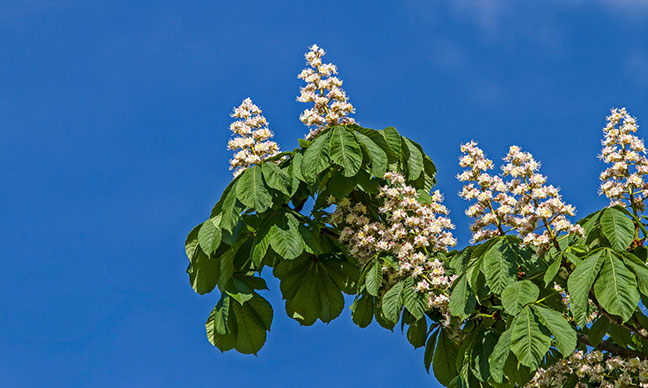Buckeyes are unique tree species, known for their gorgeous, early spring blooms and for the seeds from which the name of this distinctive family of trees is derived. The nut-like seeds are believed to attract good luck, and some parents still have their kids carry them around as a charm.
The Texas buckeye tree, one of the most popular Texas native trees, has been used for commercial and residential landscaping for many years. The residents love it not only for its showy clusters of firecracker-shaped blossoms but also for its ability to flourish even in the harshest of conditions with little maintenance. Keep reading to find out more about the magnificent buckeye tree Texas species.
Texas Buckeye Tree Place In History
In addition to bringing good fortune, the seeds of a buckeye tree have been found to contain outstanding medicinal properties. And while highly poisonous, they were used to treat rheumatism and other minor ailments by Native Americans who roasted and leached them to get rid of the toxins.
Pioneering families also used buckeye seed kernels to make soap and the tree’s wood to carve baby cradles. Before the invention of synthetic material, the wood of a buckeye tree was used to manufacture artificial limbs.
Will Buckeye Trees Grow In Texas?
Absolutely! Buckeye trees will grow in Texas, and there is a native species that does well in this state. The native Texas buckeye tree, also known as the Ohio buckeye is well adapted to the different climatic conditions experienced in different parts of Texas. It is a small tree with a canopy spread almost equal to its height. Buckeye tree Texas species will not grow any taller or wider than 40 feet, making it perfect for landowners looking for small trees to plant in Texas.
What makes these trees especially exceptional is their early blooming; Texas buckeyes produce flowers as early as most wildflowers producing plants. They also green up early, meaning, they shed their foliage before other trees too.
You will identify a Texas buckeye by its thick, rounded canopy and deeply cracked, gray bark. The beautiful yellow and orange color show its leaves display toward the end of summer or in the fall is also a sight to behold.
Related Post: Fall In Texas
Is A Buckeye Tree Poisonous?
Yes, if ingested, a buckeye tree can be highly poisonous. The bark, leaves, and seeds contain alkaloids, saponin aescin, and glycoside aesculin, which can be extremely toxic for both humans and cattle. For this reason, many property owners prefer planting it in a spot a little further away from their yards or places where their cattle graze to prevent human and animal poisoning. The tree can cause stupor, diarrhea, vomiting, paralysis, or even death.
Native Americans, however, used buckeye seeds for food but this was after peeling and boiling them to remove toxins. They also roasted them before grinding them into flour. Most experts warn against consuming raw buckeye seeds; eating too many can cause diarrhea and vomiting. Squirrels are the only living things said to consume buckeyes without ill side effects. Some people argue that squirrels know which parts of the seeds are poisonous and leave those.
Are Red Buckeye Trees Messy?
Yes, the fruits of a red buckeye tree can be messy in a landscape and may require regular clean up, perhaps another reason to plant the tree in a spot away from your house. Buckeye trees also drop leaves occasionally, and this could be a problem if you are not planning on raking your yard often. Having the tree in a place where it is not likely to mess up your yard would, therefore, be a great idea; it would also lower the risk of poisoning domestic animals.
Things You Need To Know About Growing A Texas Buckeye Tree
Buckeyes can be a great option for gardeners looking for good flowering trees for Texas. If you would like to have some on your property, here are a few things you should know:
1. Moisture Is A Must
Like any other tree you have on your property, buckeyes will need some water to grow. They will flourish in well-drained, moist – not wet – soil. In the wild, buckeye tree Texas species tend to thrive near rivers and streams, meaning, you need to provide an environment almost similar to this if you hope to get the most out of your trees.
You will find that these trees often shed leaves in the summer to further conserve moisture; so watering the plant often will help it flourish during those hot, dry months.
2. Don’t Give Too Much Shade
Although Texas buckeyes tolerate shade, they love environments with full sunshine, preferably where they receive at least six hours of direct sunlight daily.
3. Trimming Often
The deep shade created by buckeyes will hardly allow any other plant to grow underneath the tree. Regular trimming is, therefore, important if you hope to grow some vegetation underneath these trees.
Pruning removes excess leaves from the tree allowing sunlight to penetrate through its canopy to the region beneath it. When the plants underneath the tree receive enough sunlight, they are able to make their own food, which enhances their growth. And just like the vegetation beneath your trees, this proper sunlight penetration is beneficial to your buckeyes, as it promotes growth, keeping your trees looking healthy and vibrant.
But pruning can only benefit your trees if it is done properly. If you are just getting started with gardening and have no prior experience in tree pruning, we advise working with an expert. Any professional tree trimming Texas service will know where and what to cut and can prevent you from making irreversible chopping mistakes.
The Local Tree Experts Overview
The Texas buckeye is an amazing tree, but one that should be planted with caution due to its toxic nature. It will grow anywhere as long as the area has well-drained soil and receives enough sunlight. Remember to water the trees during the dry season and make sure to have them pruned regularly to enhance their growth.




